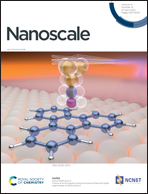Solvothermally-derived nanoglass as a highly bioactive material†
Abstract
A highly bioactive glass solvBG76 in a binary system 76SiO2–24CaO (wt%) was prepared following a solvothermal path of the synthesis. The facile synthesis, in terms of the steps and reagents needed, enabled the achievement of a mesoporous material. Many factors such as nano-size (<50 nm), different morphology (non-spherical), use of an unconventional network modifier (calcium hydroxide) during the synthesis, a structure free of crystalline impurities, and textural properties greatly enhanced the kinetic deposition process of hydroxyapatite (HA) when contacting with physiological fluids. The formation of a HA layer on the glass was analyzed by various techniques, namely XRD, IR-ATR, Raman, XPS, EDS analyses, SEM, and HR-TEM imaging. The results obtained were compared to the 45S5 glass tested as a reference biomaterial as well as 70S30C—a glass with similar size and composition to reported solvBG76 but obtained by the conventional sol–gel method. For the first time, superior apatite-mineralization ability in less than 1 h in a physiological-like buffer was achieved. This unique bioactivity is accompanied by biocompatibility and hemocompatibility, which was indicated by a set of various assays in human dermal fibroblasts and MC3T3 mouse osteoblast precursor cells, as well as hemolytic activity determination.



 Please wait while we load your content...
Please wait while we load your content...